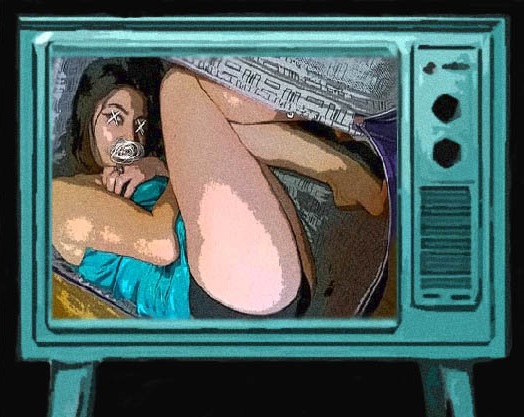The Great Onscreen Sausage Fest

Woman (n.) (according to Hollywood): object of conquest, love interest, useless sidekick, pretty decoration. Human being? No way.
2015 is going to be a big year for Hollywood. They’ve got Jurassic World, Star Wars, and a new Avengers movie lined up for release and ready to rake in the moolah. Just like every year, people will line up to watch superheroes take out the bad guys. And just like every year, the people on our screens are going to be men, for the most part. Just like every year, we’re going to see men fighting crime, men fighting for the love of their lives, men fighting for their rights, men doing good things and bad things and men just generally living their lives.
So are we doing anything about that? There is in fact a test to gauge female representation in a work of fiction, as outlined by Alison Bechdel, recent recipient of the MacArthur Genius Grant, who got quite understandably sick of the sausage fest on the silver screen. In 1985, one of her comic strips, Dykes To Watch Out For, explains what later came to be known as the Bechdel Test (Bechdel, however, credits her friend Liz Wallace for the idea).
One: Are there two (named) women in the film/book/TV show?
Two: Do they talk to each other?
Three: About something other than a man?
So basically there need to be, as Colin Stokes says: “Two women, who exist, and talk about stuff.” That happens, right?
But it turns out that on average, a little more than half of all films fail the test, and those that do pass do so dubiously: either with one rushed scene that lasts under a minute, or with the women typically talking about a vague mix of marriage, babies, and men. If you look at only Hollywood’s popular blockbusters, the track record is worse. 10 out of 14 Pixar films fail the test, as did about half of last year’s Oscar nominees.
Fortunately, the norm of women being typically vapid, one-dimensional male supporters seems to be reversing in the last couple of years, with the releases of The Hunger Games series, Palo Alto, Maleficent (Angelina Jolie? Enough said), and a host of others. In fact, out of the top 50 films in 2013, films that passed the Bechdel test (Mama, Elysium, Frozen, Catching Fire) grossed more totally (about 1.5 billion more) than those that didn’t (Star Trek Into Darkness, The Hobbit: The Desolation of Smaug, Anchorman 2: The Legend Continues). If you want more detailed statistics about women in films and the things they talk about (and what they’re wearing when they talk), Ross McGuinness outlines it comprehensively here.
More than just the women on screen, we also need to talk about women behind the camera, and the target female consumers. There’s a common (mis)conception that no one wants to watch a film with a strong female presence, because the target audience is young and male. Blogger Jennifer Kesley writes in this wonderful article about her experience in film school at UCLA, where she was told repeatedly that scripts with multifaceted, conversing women were not something people were going to pay to watch.
“According to Hollywood,” she writes, “if two women came on screen and started talking, the target male audience’s brain would glaze over and assume the women were talking about nail polish or shoes or something that didn’t pertain to the story. Only if they heard the name of a man in the story would they tune back in. By having women talk to each other about something other than men, I was ‘losing the audience’.”
However, what Kesley was being told is clearly getting turned on its head now, even in film industries abroad. Last year, Bollywood (India’s Mumbai-based film industry, the largest in the world) released Queen, the story of a young woman Rani (played by actress Kangna Ranaut) who decides to embark on a solo honeymoon in Europe after being jilted by her to-be husband the day before her wedding. In Paris, she makes a friend in Indian-Spanish-French Vijay (hooray for strong female friendships!), who helps her around the city, and eventually sees her off to Amsterdam. It was the biggest hit of the season (it made a profit of about 13 million dollars, which is big for Bollywood). And guess what? The theatre was occupied by a great deal of men, all loving it just as much as the women. And this in a country where ninety percent of the films that come out feature a hypermasculine “hero” and a damsel-in-distress “heroine” who is there to be saved. So where’s the flaw in whole people-don’t-want-women-on-screen logic?
There are a few issues to be considered.
Issue one: The widespread Bechdel failure rate of mainstream cinema stems not from a “Women are incompetent and don’t deserve the good bits in cinema” thought process, but from a more deeply ingrained sexism that paints the male experience as the human, universal one. As society and civilization have grown into what they are today, our mainstream history, our philosophy, the very foundation of thought have all been laid by men, who have propagated their experience as the default one. The female perspective is very conspicuously not male. For example, the decision to make the new Ghostbusters cast “all-female” has been something that people have been protesting against, saying things like “but what’s the need to make it all women? And all white women at that?” Somehow no one questions it when Hollywood makes all-white, all-male films. It’s because they don’t notice. Male-led films are just films about people doing things. Female-led films are films about women doing women things and dealing with women issues and voila, misogyny comes into play and suddenly no one wants to watch it and it’s got a whole lot to prove. Which brings us to the second issue.
Issue two: In the event that a female-led film is produced, there’s a lot riding on its success/failure: if it fails, producers take it as an opportunity to say “See? No one wants to watch powerful women on screen. Now let’s get back to churning out tedious mayonnaise white men to get the big bucks.” No fair.
Issue three: It’s not just about seeing powerful women up there. Yes, we do need our Katniss Everdeens and Hermione Grangers, but the issue at hand is one of plurality. We need to see women who are complex human beings, whose identities go beyond their femininity (see also: Gone Girl, Orphan Black, Grey’s Anatomy, Parks and Recreation). Because the radical fact of the matter is that, that’s what real women are like. Deal with it. As of now, it seems as if women either have to be sex objects or warriors to command any kind of recognition.
A lot of people are quick to retaliate, stating that the point of entertainment is that it’s escapist and need not mirror reality, so why make a big deal of all this “politically correct” media representation?
Because media and entertainment shape our lives in a huge way – they shape our expectations of ourselves, our way of perceiving the reality of the world around us. They shape our idea of what the human experience is all about. And with a constant barrage of literature and films that have men (mostly white men) at the helm, that’s what we see as human, as the default. I grew up in India, but I read English books and watched English films, and as a result, the stories and poems I wrote as a child have Johns and Maries doing things, not Kalpanas and Krishnas. Because I saw my own ethnicity as aberrant. That is the danger of consistently whitewashed male-led entertainment.
That said, not every film has to pass the Bechdel test. For example, if you’re making a film set in a military camp in the 1940s, chances are you won’t find a lot of estrogen there. But the way it is now, even if there are women out and about, they either support men or talk about men. Fun fact: The Sex And The City series fails the Bechdel test. Seriously. Four intelligent women, two movies, and all they could talk about was boys.
Bottom line: If a film fails the test, it is not necessarily sexist. And if a film passes the test, it is not necessarily fair to women. The test is just an indicator of the general attitude of the industry when it comes to women – for example, Shrek fails the Bechdel test but as a work of fiction it isn’t in the least sexist and even carries an important (if cheesy) message about external beauty and how “what really matters is on the inside.”
However, the way Hollywood goes about things, there aren’t women even where you’d expect to find them, i.e. mass failure of the test implies an undercurrent of sexism in the entire industry. This needs to change. Women are human beings, and it’s about time the film industry took note.




